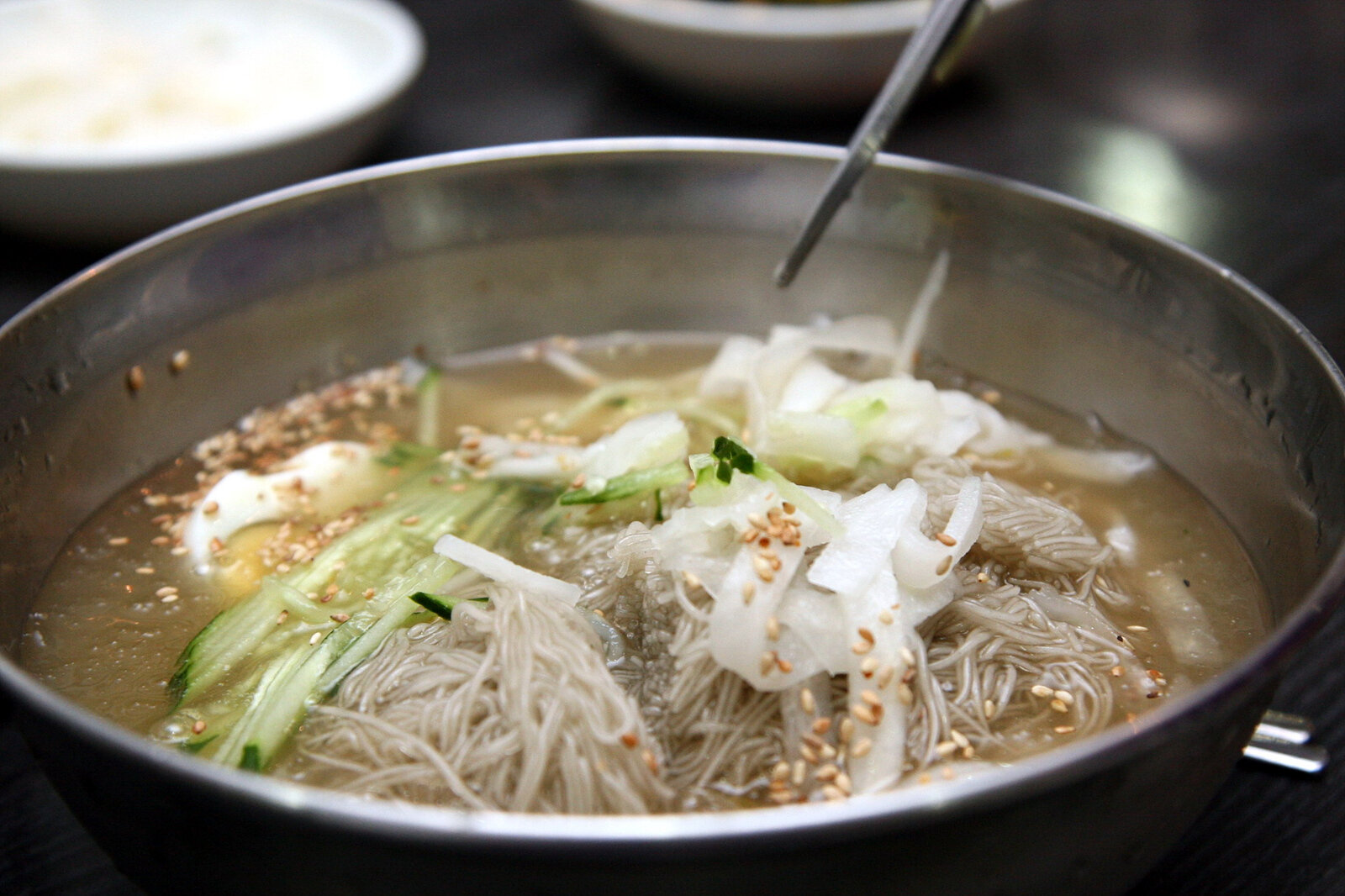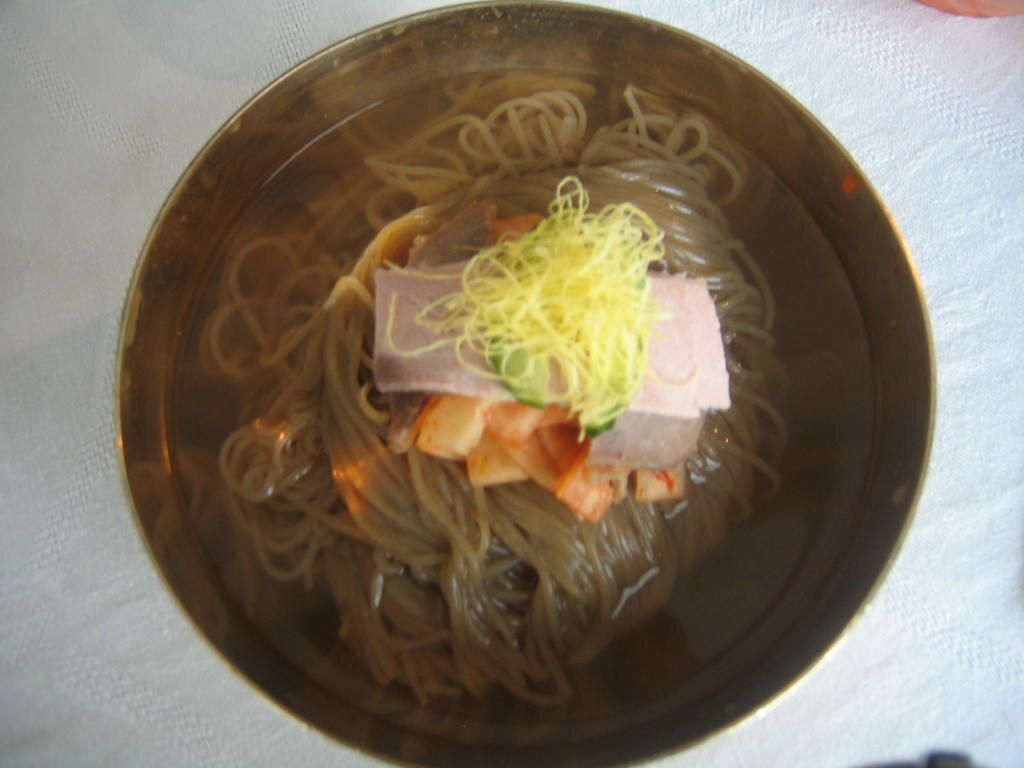On a long divided peninsula, North Korea’s cuisine offers a glimpse of long-repressed unity
Recipe: check out EATE’s take on Pyongyang Naengmyeon here
Pyongyang skyline
When the war in Korea ended in 1953, a playground for Cold War tensions between the Soviet Union and the United States, the 38th parallel across the peninsula marked a division between two of the world’s poorest nations. Although the regions went in opposite directions - the South into American-inspired democratic and economic success and the North engaged in communist juche or self-reliance under a totalitarian leadership - they still share a table. North and South Korean culinary practices originate from the same historical dishes, and whilst they have adapted separately over the last 70 years, the fundamentals remain. As Westerners, the idea of North Korean ‘cuisine’ may seem unfeasible; a country under debilitating levels of restriction on freedoms, 60% of the population in absolute poverty and the memory of the 1994-1998 famine still fresh in our minds does not appear to be a place likely of ‘gourmet’ standards of food. The bleak food insecurity of the region is down to both geography and politics, as North Korea is wonderfully mountainous and blessed with a warm, dry climate. This, in turn, is not conducive to successful self-reliant agriculture. Whilst accepting very little food aid from abroad due to adherence to the nationalistic paradigm of the country, North Koreans still suffer from food shortages and stunted growth, even years after the famine ended.
It is impossible to talk about North Korean food without songbun; this is a government-founded system of rations wherein each family is ascribed a status based on their trustworthiness to the leader of the country. 25% of people, mostly the more privileged class who are allowed to live in Pyongyang, are counted as the ‘core class’. These individuals are often families who have behaved obediently, perhaps held government positions and never been involved in deviance against the government. As they are deemed more worthy by the state due to their compliance with the Kim dynasty, they are granted with roughly 500g of food per day, mainly consisting of rice and kimchi, two ingredients that have remained unchanged in the Northern region of the peninsula. In the lower levels of songbun, made up of the majority of the rural population, citizens can be subjected to far fewer rations and a restrictive diet of rice, and any food scraps leftover from markets or farm production. The unbearable conditions of the 1994 famine has forever changed the food landscape in North Korea due to the resistance from young people that it has incited.
Due to living through the extreme neglect of the North Korean state during the 1990s as the economy collapsed and the divide between the elite and the rest stretched even further, the creation of black markets or jangmadang began. The state still attempts to reprimand market traders and shut down the private enterprises, but as it became a necessary survival means post-famine, it is harder to restrict. Some food can be traded secretly at the Chinese border, potatoes and sweet peppers from China traded for rice cakes and cold noodles from Korea. However, through the efforts of the jangmadang generation and the ability to access ingredients through trading externally as well as internally has allowed for the increased visibility of the North Korean palette. The dish most commonly associated with North Korea, and popularised in both China and South Korea, is Pyongyang Naengmyeon. Sold in the markets and made in homes from traded ingredients, the dish represents the remaining ties between the two sides of the country.
Naengmyeon, translated directly to ‘cold noodle’, originated from Northern regions such as Pyongyang and Hamhung during the Joseon Dynasty in Korea, long before the division of the peninsula. Buckwheat noodles are cooked briefly and served in a rich broth made of three different meats, often cooked for over 15 hours and then chilled. Ice cubes are placed in the broth, and then the dish is topped with julienned cucumbers and pear, strips of radish, thin slices of beef brisket and a boiled egg. A tangy mustard and vinegar sauce is usually added on top, although it can be switched for a spicier gochujang based version. Many varieties have evolved since the Korean War, as in the South, cold noodles have become popularised as a summer’s day dish due to the ice cubes in the broth and refreshing flavours of the pear and radish; mul naengmyeon and bibim naengmyeon are often spicier than their original counterpart. Once divided, the North and South cuisines began to also part ways; the South americanised into corn dogs, skewers, army stew full of spam and sliced cheese and baked beans. The North had no choice but to remain with the recipes of the peninsula, with staples such as japchae noodles, kimchi and doenjang jjigae stew (not dissimilar to Japanese miso).
However, the pity we hold for the oppression of the North Koren people unfortunately leeches into the assumption that they cannot create dishes full of flavour like the South Koreans can. Korean food has been making headway in the Western market in the last five years, with KBBQ and mukbangs on YouTube becoming intriguing to the Western eye after years of our love for Chinese, Japanese and Thai cuisines. The addition of more East Asian flavours is welcomed warmly. But of course, this is all focused on South Korea. When we eat kimchi, book at a barbeque restaurant or watch heart-warming recipe videos for ‘authentic Korean dishes’, our minds do not immediately connect to the poverty-stricken state that is starved through songbun.
Luckily, this narrative of North Korea is slowly beginning to change. With more documentaries, more charities and more awareness for the humanity of North Korean people, rather than the focus on the nuclear weapons and the terrifying propaganda of the state, we are moving into a clearer picture of the country which is slowly revolutionising through increasing numbers of successful defectors and the ongoing victories of the jangmadang generation. In Seoul, many North Korean refugees have opened naengmyeon shops, specifically serving authentic naengmyeon. After the division in the war, the flavour of the original Pyongyang naengmyeon was lost, as the recipe was gradually altered to fit the changing tastes of the country. Natives are shocked to try the rich and flavourful Pyongyang naengmyeon made by North Korean refugees, shocked to discover that the flavours of Korean cooking - the spicy, umami flavour cut through with a sour punch - is not one of the things that has been torn away from their Northern counterparts.
Despite their division for over 60 years, the Korean people are still unified. They share not only language and history, but a unique and vibrant cuisine. With so many commonalities stripped away, Pyongyang naengmyeon remains as one decidedly Korean dish. Many young people who did not experience the war do not associate the dish with North Korea and the memories of eating naengmyeon through the nostalgia of pre-war times. They just know it as what it is - authentic Korean food.
Mia Purcell
New to food writing, Mia has worked in kitchens and speciality coffee for eight years, developing a passion for not only cooking, but researching and writing about food. She specialises in East Asian cuisine, and the constantly evolving globalised palette. Alongside writing, Mia runs a handmade chocolate truffle business online and studies MA Media and International Development at UEA. To see more from her business, visit @one9onetruffles on Instagram.
Gallery pictures by: ayustety (a flickr user) - https://www.flickr.com/photos/ayustety/12743706/, CC BY-SA 2.0, Jinho Jung at Flickr from South Korea - flickr.com, CC BY 2.0, Uri Tours (uritours.com), CC BY-SA 2.0






